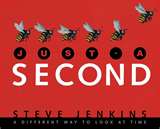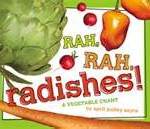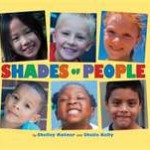Planting the Wild Garden
 Everywhere in my yard, plants are growing, many of which I didn’t plant (some call them weeds, I call them uninvited green guests.) How do all those plants in the meadows, by the creek beds, in fields, and by the sides of roads get there? In Planting the Wild Garden written by Kathryn O. Galbraith and gorgeously illustrated by my friend Wendy Anderson Halperin, we learn that we helped those plants: “wind and water. Birds and animals. Plants and people. All of us. Together.”
Everywhere in my yard, plants are growing, many of which I didn’t plant (some call them weeds, I call them uninvited green guests.) How do all those plants in the meadows, by the creek beds, in fields, and by the sides of roads get there? In Planting the Wild Garden written by Kathryn O. Galbraith and gorgeously illustrated by my friend Wendy Anderson Halperin, we learn that we helped those plants: “wind and water. Birds and animals. Plants and people. All of us. Together.”
I love Galbraith’s easy, poetic style for nonfiction. This book doesn’t read like an old science text book, although it is bursting with information. Scotch broom seeds pop out like popcorn in the heat, cockleburs are transplanted when they catch on the fur of a fox, and dandelion seeds are blown to new places by a child. Each page is lushly and accurately illustrated by Halperin, whose award-winning project drawingchildrenintoreading.com is worth investigating if you are an educator or parent of budding readers. After reading this book aloud, give students colored pencils and paper for them to draw the seed transportation method they find most interesting. Read the book aloud twice as children draw, rereading pages students want to hear. Students can practice and demonstrate their listening comprehension through their art. Encourage them to use labels and descriptions to explain their art, and to use onomatopoeia like Galbraith did to build writing skills. Whether this is part of a science unit on plants, a celebration of Earth Day, or a lesson to build listening comprehension, Planting the Wild Garden will plant a love of nature in young learners.
For more inspiration, please visit Kathryn Galbraith’s website: kathrynogalbraith.com and Wendy Anderson Halperin’s website: wendyhalperin.com.
Read MoreJust a Second: a different way to look at time
 How many times do you think a hummingbird beats its wings in just one second? 10? 20? Steve Jenkins makes math irresistible in Just a Second: a different way to look at time. In one second, a hummingbird beats its wings 50 times. In one minute, a grizzly bear can charge one half-mile. Just a Second is full of information that fits well into units on time, measurement, and estimation, plus it’s visually captivating with Jenkins’ signature cut-paper art. His process in making the collages for his book is really cool, and you can see a video of how his books come together on his website: stevejenkinsbooks.com.
How many times do you think a hummingbird beats its wings in just one second? 10? 20? Steve Jenkins makes math irresistible in Just a Second: a different way to look at time. In one second, a hummingbird beats its wings 50 times. In one minute, a grizzly bear can charge one half-mile. Just a Second is full of information that fits well into units on time, measurement, and estimation, plus it’s visually captivating with Jenkins’ signature cut-paper art. His process in making the collages for his book is really cool, and you can see a video of how his books come together on his website: stevejenkinsbooks.com.
Before reading Just a Second, make some predictions with your students, like how many breaths do you think an adult takes in one hour? (900!) After reading the book and checking your predictions, make and test some new predictions about time. How many jumping jacks can you do in one minute? How long will it take you to flap your arms 50 times like a hummingbird? Can you sit perfectly still and quiet for a full minute? You can compare students’ results on charts or a graph. You can even make a pictograph of your classroom results, and let students make cool representations for themselves with cut-paper art. It may take a bit longer than “just a second”, but it will be time well spent.
Read MoreRah, Rah, Radishes!
 Three cheers for April Pulley Sayre and Rah, Rah, Radishes! A Vegetable Chant! How do you make healthy eating fun? With Sayre’s vibrant photos of vegetables taken at her local farmer’s market paired with her contagious rhymes:
Three cheers for April Pulley Sayre and Rah, Rah, Radishes! A Vegetable Chant! How do you make healthy eating fun? With Sayre’s vibrant photos of vegetables taken at her local farmer’s market paired with her contagious rhymes:
“Oh boy, bok choy!
Brussels sprout.
Broccoli. Cauliflower.
Shout it out!”
Start your lesson by asking students, “What do you think kohlrabi is? How about fennel? Rutabaga?” Read Rah, Rah, Radishes! and see if your kids can discover what those uncommon words mean. Encourage kids to chime in as you reread (“Go, green bean!”) Play “Cross the Line”: all the kids stand one one side of the classroom and imagine an invisible line down the middle of the room – or put down tape if your maintenance team won’t go nuts. Say “Cross the line if you’ve tried broccoli,” asparagus, the vegetables listed in the book. Have kids brainstorm vegetables that didn’t make the book. Is a tomato a vegetable? Find out in the back of Sayre’s book! If you have time and funds, bring in some vegetables for kids to try! Take photos of the vegetables and have kids use those Logic Smarts to sort the photos – by color, by part of plant (root, stem, leaf, or fruit), by which they liked and which they didn’t. With all the gorgeous colors of fresh produce, you can make a “color wheel” using vegetables – challenge kids to eat a rainbow! Rah, Rah, Radishes, hooray healthy eating, and super job, Ms. Sayre!
For more information, visit aprilsayre.com.
Read MoreShades of People
 Peach, coffee, cocoa, copper, tan, ivory, rose, almond. So many Shades of People in this gorgeous book by Shelley Rotner and Sheila M. Kelly! I can think of no better book to read to little ones in celebration of Reverend Dr. Martin Luther King, Jr. Day. I’ve tried reading his biography in the past to kindergartners, only to have it go over many heads. This year, I’ll share Dr. King’s message of peace and acceptance with Rotner and Kelly’s spot-on writing and exquisite photographs, followed up with a fun art activity.
Peach, coffee, cocoa, copper, tan, ivory, rose, almond. So many Shades of People in this gorgeous book by Shelley Rotner and Sheila M. Kelly! I can think of no better book to read to little ones in celebration of Reverend Dr. Martin Luther King, Jr. Day. I’ve tried reading his biography in the past to kindergartners, only to have it go over many heads. This year, I’ll share Dr. King’s message of peace and acceptance with Rotner and Kelly’s spot-on writing and exquisite photographs, followed up with a fun art activity.
“Have you noticed that people come in many different shades? Not colors, exactly, but shades.” Rotner and Kelly open the door to discuss skin colors in the most lovely of ways, with photographs of smiling children. Children with golden skin, with freckles, with lusciously dark skin, with rosy pink cheeks. “Our skin is just our covering, like wrapping paper. And, you can’t tell what someone is like from the color of their skin.”
So before you read this book, wrap it up in paper so the cover can’t be seen. Hold it up for your kids to guess what the book is about. Can’t tell what’s inside just by looking at the wrapping? Just like a present! And, just like a person! Read Shades of People with your kids and talk about the descriptive adjectives. How would you describe your skin? I’m sort of peachy-ivory – how about you? After you’ve read and enjoyed the book, get out the paint and let kids paint pictures of themselves. Let them experiment with mixing colors to match their skin tones. Even if you only have the basic primaries, it’s a good science and art experiment to add a bit of red and yellow and even blue to white and black and brown. Celebrate all the colors in your classroom!
For more information, visit shelleyrotner.com.
Read More






